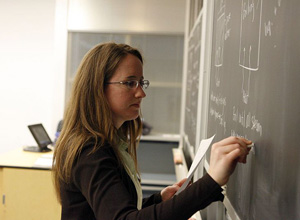« Prev Next »

College Teaching

Community Colleges
Teaching at a community college can be an interesting and rewarding experience. The students are often older and more diverse and international, which can make for fruitful discussions both in and out of class. Many of the students are taking classes specifically to build skills toward a career that will help build stability for their families and children. The classes are often smaller than at a large university, which means that the instructor often gets to know his or her students better. The emphasis at the college is on teaching, rather than research, which helps to foster the feeling that the instructor is strongly contributing to the college's overall mission.
Some community colleges rely quite heavily on part-time faculty, who sometimes do not have an office on campus. Others have made a concerted effort to have most of their faculty be full-time, as they recognize the stability that brings to their curriculum.
Four-Year Undergraduate Institutions
Teaching at an undergraduate institution can provide plenty of opportunities to do both teaching and research. Michele (interview), an assistant professor at New Mexico State University, has a Ph.D. in Biology and did postdoctoral work before obtaining her current position. The student population at New Mexico State is predominantly Hispanic and Native American, and Michele is working towards building the number of minorities who are cancer researchers. The majority of her time is spent teaching microbiology, general biology, and cancer biology to undergraduates. In addition, 15% of her time is devoted to research; she is asking questions about how students best learn about cancer. Her research has been published in some of the best biology education journals and she has won awards for her excellent teaching skills. She feels that, because good teaching is emphasized and valued at her institution, she is therefore valued in her job. Because some undergraduates join her as research interns, she is able to get to know undergraduates quite well, and the feeling that she is mentoring the next generation of biologists is very gratifying.
Undergraduate institutions can be large or small. Smaller institutions will have smaller class sizes, which can lead to having more interaction with the students, which many faculty really enjoy and find fulfilling. Smaller institutions also have a smaller number of faculty members; this can be either good or bad, depending on the kind of culture you prefer. Increasingly, many institutions want their faculty to focus on both teaching and have a significant research program because they want their undergraduates to have opportunities to do research. Most faculty who do both teaching and research do more of their research in the summer, when the teaching loads are much lighter.
Research Universities
Even at research universities, many professors teach in addition to doing research. For example, some professors have a full research program and also teach courses to graduate students. They generally love to teach and find that interacting with the students is interesting and stimulating. Nevertheless, they have a lighter teaching load than a professor at a primarily undergraduate institution, which allows them to devote most of their time to their research program.
Undergraduate courses are often larger than at a primarily undergraduate institution, which can lead to a feeling of not having enough personal contact with students. On the other hand, there are always students who stand out and can be mentored to do undergraduate research.

Within this Subject (45)




















